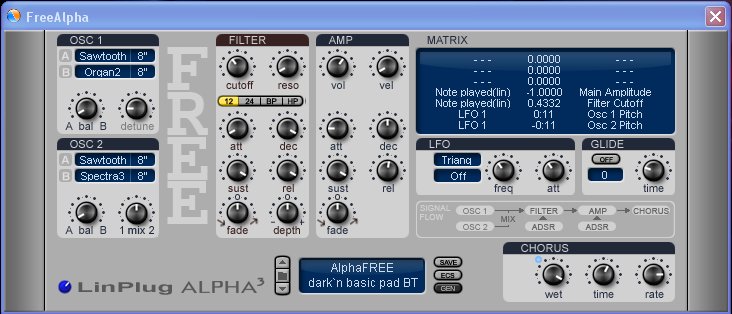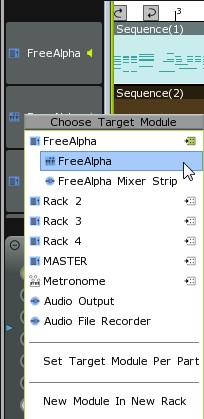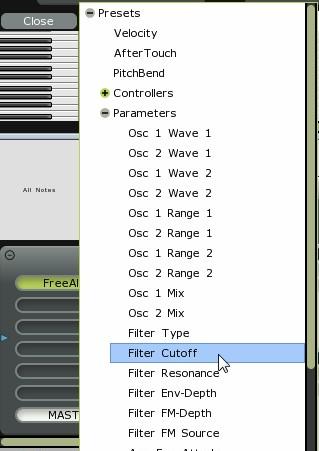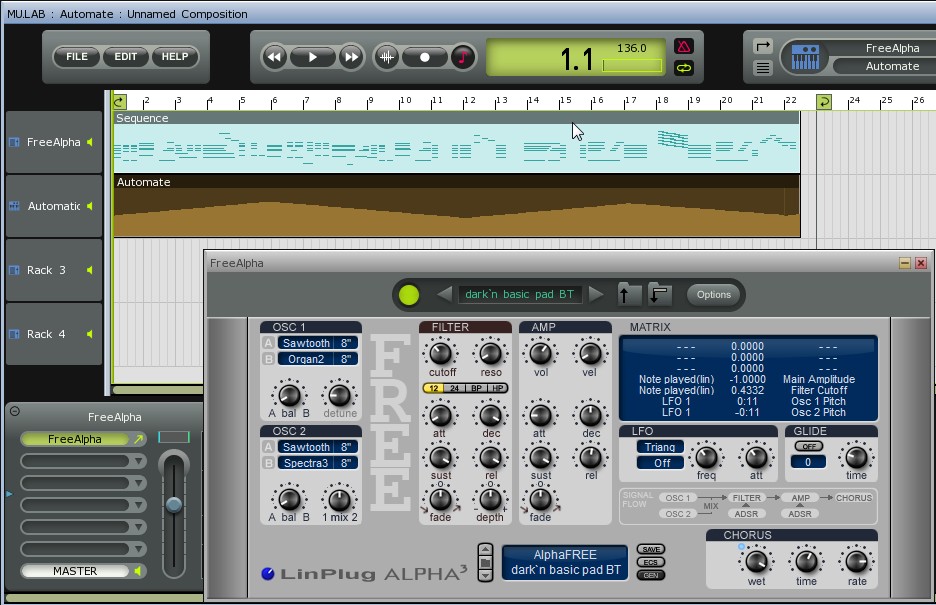
It is sometimes advantageous to change parameters of the synthesized sound over time - and do it automatically at the exact moment that is required or at a predetermined rate. This can also be done manually by just turning the knobs of the VSTi or Rack strip while the part is playing, but doing this manually can be inaccurate and never as precise as setting the parameter levels into the track ahead of time at precise positions in the piece and being able to set the levels exactly as needed. In MULAB terms this means changing the parameters of the Part Player - which may be a VST synth or effect or a Rack strip. In a few words, you are programming a specific control parameter by drawing in the parameter level over time.
Some VST plugins, do not support automation because they were not designed to make their parameters available to the host program. And some host programs have not implemented the ability to control VST parameters even if they are made available. So the choice of either the host program or the VST Plugin will govern whether you can influence the sound through the use of automation. We are fortunate that MULAB has the capability of controlling VST and mixer strip parameters by entering control events. These events are very similar to control events that are included with MIDI sequences and are also entered in the controller matrix which is found just beneath the note editor in the Midi editor window. The parameter to be controlled (automated) is named in the lower left corner of the Midi Editor window which usually defaults to - All Notes - typically velocity. By clicking on the name of the event, a list of parameter that can be controlled will be displayed. The parameter to be controlled (automated) can then be selected. These are selectable under the Parameter listing and will reflect those parameters that are the target of the track.
For this tutorial, we will be using another VSTi known as Free Alpha 3. This is an extremely versatile synth that has been made available by Linplug for both the PC and the MAC. It is capable of creating a variety of electronic sounds that can be used in anyone's music.
Note: Free Alpha 3 replaces an earlier version of Free Alpha which may be used as well with the exception that many of the old patches will not work with the new version. We advise you to use the latest version of Free Alpha in order to complete the tutorial as easily as possible.

To get your very own copy of Free Alpha 3, click on this link to the Linplug website - Look under instruments for Free Alpha 3 and select the download for your platform. All of Linplugs products are listed on this page, but for this exercise you should download only the Free Alpha 3. Both PC version (.exe) and OSX version (.dmg) can be downloaded from this page as well as the Alpha manual (PDF).
If you have been following our tutorial, you will have downloaded the FreeAlpha installer to the Download directory. Now click on the installer and install Free Alpha into your VST directory. The next step is to Edit>VST Plugin Manager and add this Plugin to the list of Mulab plugins.
For this exercise, you will be importing a preexisting midi file into MULAB; creating a new sequence track for the automation; and then automating the new sequence track with automation that controls the output of Free Alpha. At the same time we will be demonstrating the ability to route the output of one Rack strip to another.
 For
this demonstration you can use any midi file, preferably a single instrument,
but we have provided a midi file that will just fill the bill and allow a quick
demo of the automation process. So download the midi file - example-automate.mid
onto your machine. Please remember where you downloaded the file to. If it was
downloaded to the Download Directory, then this is where you will be
able to find it when it is imported into MULAB.
For
this demonstration you can use any midi file, preferably a single instrument,
but we have provided a midi file that will just fill the bill and allow a quick
demo of the automation process. So download the midi file - example-automate.mid
onto your machine. Please remember where you downloaded the file to. If it was
downloaded to the Download Directory, then this is where you will be
able to find it when it is imported into MULAB.
Open up MULAB as a new session, save the session as 'Automate' and import the example-automate.mid file into MULAB. (Importing midi files were covered in the Audio Recording tutorial.)
To import this file, click on the FILE Button in the upper left corner of MULAB. The drop down menu will look like this. Click on Import MIDI File and then look for the example-automate.mid file in the directory tree. Locate the file, highlight it and click on OK.
Merge this into the current composition starting with the track named Rack 1 at position 1.1.0000.
 Now
Right Click on the midi sequence track header and choose the target as Rack 1.
Move your mouse down to Rack 1 and click on the 1st slot. Select
FreeAlpha from the list of VST synths. The FreeAlpha VST will be
installed in the Rack. On the Free Alpha Synth display, the
bottom center box shows the current preset and provides arrows to
scroll through the list of presets. Clicking on the name will provide a
window showing all the presets available in the current bank. Select
the dark'n basic pad BT Preset (see the Free Alpha picture above
to help identify this area).
Now
Right Click on the midi sequence track header and choose the target as Rack 1.
Move your mouse down to Rack 1 and click on the 1st slot. Select
FreeAlpha from the list of VST synths. The FreeAlpha VST will be
installed in the Rack. On the Free Alpha Synth display, the
bottom center box shows the current preset and provides arrows to
scroll through the list of presets. Clicking on the name will provide a
window showing all the presets available in the current bank. Select
the dark'n basic pad BT Preset (see the Free Alpha picture above
to help identify this area).
Note: The set of presets for PC and for MAC are entirely different! And they may have changed over time. So if you can't locate the dark'n basic pad BT Preset, it is not important for this tutorial. Just select a preset that you are comfortable with.
Now we are going to setup the automation sequence. Double click and drag a new sequence part on track 2 (Rack 2). Drag it out to the same length as the example-automate sequence. Now, right click on the track 2 header and choose Target Module. To the right of the FreeAlpha entry there is a tree icon for detailed selection. Click it and choose FreeAlpha as a target. This will direct the sequence on this track to VST plugin itself (as opposed to the Rack Mixer Strip).
The track name will change to FreeAlpha. To differentiate from the Sequence above we could rename this to 'Automation'.Lets expand the view to cover all the measures in our sequence so use the '-' key in the horizontal (time axis) to expand the number of measures in view beyond measure 23 where our sequence ends. Also drag the sequence Loop End indicator out beyond measure 23.
 We are going to vary the Filter Cutoff Parameter during the sequence to change the timbre of the patch.
We are going to vary the Filter Cutoff Parameter during the sequence to change the timbre of the patch.
Play the sequence again, and this time slowly rotate the Filter Cutoff knob from about 10 O'clock to about 2 O'clock. You will hear the timbre of the patch change as we change the cutoff frequency. Stop the playback so we can automate the moves that you just made.
NOTE: Mulab provides for recording the movement of VST plugin controls which is another method of creating automation. We will first discuss creating a sequence using step editing.
For clarity we have renamed this sequence to Automate. You can rename a sequence by right clicking on the track and selecting Rename. Double-click on this new sequence track. This will bring up the Sequence Editor. The lower matrix of the Sequence Editor is for control automation for both midi control data and VST parameter controls.
Click on the lower left box which contains the name of the control. Typically the default here is All Notes (velocity). Open the Parameters drop down and you will see a list of all the VST plugin controls that may be affected. (Note: this is available because we specified this module as the target of this track).
Click on Filter Cutoff to select it.
 Now you can draw an envelope that directs the Filter Cutoff Parameter to follow over time.
Now you can draw an envelope that directs the Filter Cutoff Parameter to follow over time.
Click on the Automate sequence and press the delete key or right click and select delete. This will delete the sequence. We will want a new sequence in its place.
Now setup for midi record - Check that the midi record icon is red. Toggle the Loop Play off. Click on the Rack 2 header (Automation). Click on Record button. As the playback processes, slowly move the Filter Cutoff knob from 10 O'clock to 2 O'clock and back. When playback is complete, hit stop (press space).
A new sequence will appear. You can double-click the sequence and clean it up to your satisfaction, rename it, etc.
Here are the steps to using Automation ...
1. Create a sequence clip for the length of the automation.
2. Designate the Target to be automated by selecting the Rack target.
3. Double-click on the new sequence clip.
4. Click on the lower left corner (controller name)
5. Select the parameter to be automated from the parameter tree for this target.
6. use the pencil tool to draw the levels of the selected parameter into the
controller grid.
Once this is completed, you can close the edit window for the sequence clip
Or
1. You can wing it and record the automation using midi record and then clean up the recorded sequence.
That's it.